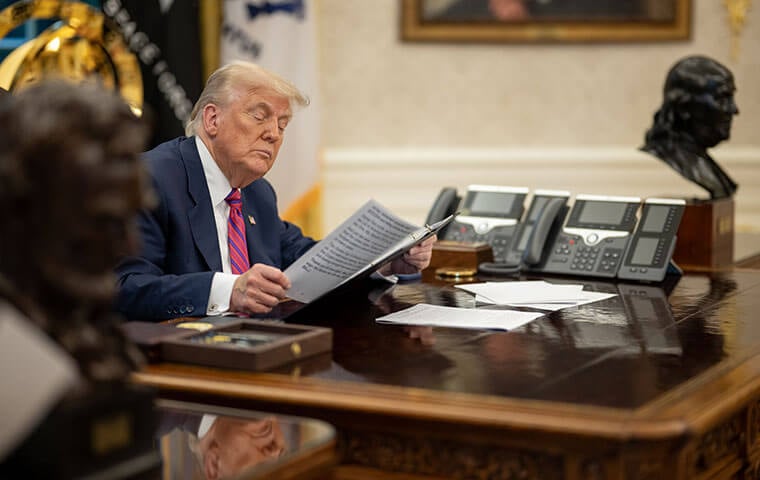 President Trump posing with a copy of the stable coins Genius Act, July 18 2025. The White house argues that Schedule G is needed to implement policy prescribed "through our elections", while critics such as the Partnership for Public Service decried further politicizing the federal workforce. Image: Daniel Torok/White House/News Pictures/Shutterstock
By: FEDweek Staff
President Trump posing with a copy of the stable coins Genius Act, July 18 2025. The White house argues that Schedule G is needed to implement policy prescribed "through our elections", while critics such as the Partnership for Public Service decried further politicizing the federal workforce. Image: Daniel Torok/White House/News Pictures/Shutterstock
By: FEDweek StaffPresident Trump has formally launched the excepted service “Schedule Policy/Career” employment category—successor to the short-lived Schedule F of his first administration—meanwhile creating a new category of political appointees for positions to “help faithfully implement the President’s policy agenda.”
Like Schedule F, Schedule Policy/Career is for positions of “a confidential, policy-determining, policy-making, or policy-advocating character not normally subject to change as a result of a Presidential transition. The added category, Schedule G, meanwhile is for such positions that are subject to that change.
While the order puts Schedule Policy/Career on the books—President Biden had promptly revoked the 2020 order to create Schedule F—the OPM has yet to finalize rules to carry it out, as required by an earlier executive order. Those rules are needed because the Biden administration further had issued rules to prevent a return of Schedule F or something like it.
Finalization of those rules is expected soon, as are lists of positions agencies identify as falling under Schedule Policy/Career. Federal employee unions have said the number could be well above the administration’s estimate of 50,000, given how broadly agencies that had started work on Schedule F before it was revoked had interpreted it. Further, the pending OPM rules would add a range of roles.
Under those rules, as with Schedule F, those who would be designated as Schedule Policy/Career would become at-will employees without the standard competitive service rights to challenge disciplinary actions up through firing on grounds of either performance or conduct. Union representation and grievance rights, where applicable also would be revoked.
In contrast, the designation would be left to the President, not OPM, and competitive service-type hiring procedures including veterans’ preference would continue to apply. Those changes are widely seen as designed to counter legal challenges, which already are pending.
The order meanwhile says that while Schedule Policy/Career now exists for career employees, “There is, however, no excepted service schedule for noncareer positions of a policy-making or policy-advocating character” and that one is needed for “conditions of good administration, including eliminating this gap in excepted service schedules and improving the operations of the Department of Veterans Affairs.”
Says an accompanying White House statement, “Schedule G employees will be hired to help faithfully implement the President’s policy agenda . . . Existing types of employees, like Schedule C and Schedule Policy/Career, do not provide for non-career appointments to policy-making or policy-advocating roles, leaving a gap in federal hiring categories.”
“Creating Schedule G fills this gap and facilitates appointments of non-career federal employees who will serve temporarily and implement the policy agenda prescribed by the American people through our elections. This will improve operations, particularly in agencies like the Department of Veterans Affairs, by streamlining appointments for key policy roles,” it says.
While the order and statement both refer only to the VA, however, the authority would be government-wide and there was no projection of how many positions might fall under Schedule G.
The Partnership for Public Service said it “is unnecessary and makes an overly-complicated system even more confusing” and “is another misguided attempt by the administration to further politicize the federal workforce.”
“A president already has the power to make more than 4,000 political appointments, far more than other democracies, most of which number their political appointees in the 10s. Aside from Senate-confirmed political appointees, the President can also make hundreds of political appointments through Schedule C and other authorities,” it said.
OPM: Impact of RIFs Could Be Much Larger than Commonly Used Numbers. Or Maybe Less.
Uneasy Wait on RIFs Hangs over Federal Workforce; Courts May Yet Play a Role
Agencies Should Weigh Impact on Employees of Return to Worksite, Says Report
Audit: PSHB Program at Risk of Underfunding, Understaffing; No Plan B
Supreme Court Clears Way for Mass RIFs as OPM Cites Wave of ‘Deferred Resignations’
Rubio’s State Department Restructuring Cuts 1,353 Federal Jobs
OPM Wants Supervisors to Produce a ‘Positive and Compliant’ Federal Workplace
See also,
Work Longer or Take the FERS Supplement Now: Which is Better?
Doubling Your TSP (C Fund vs G Fund)
How to Estimate a FERS Special Retirement Supplement (calculator!)

